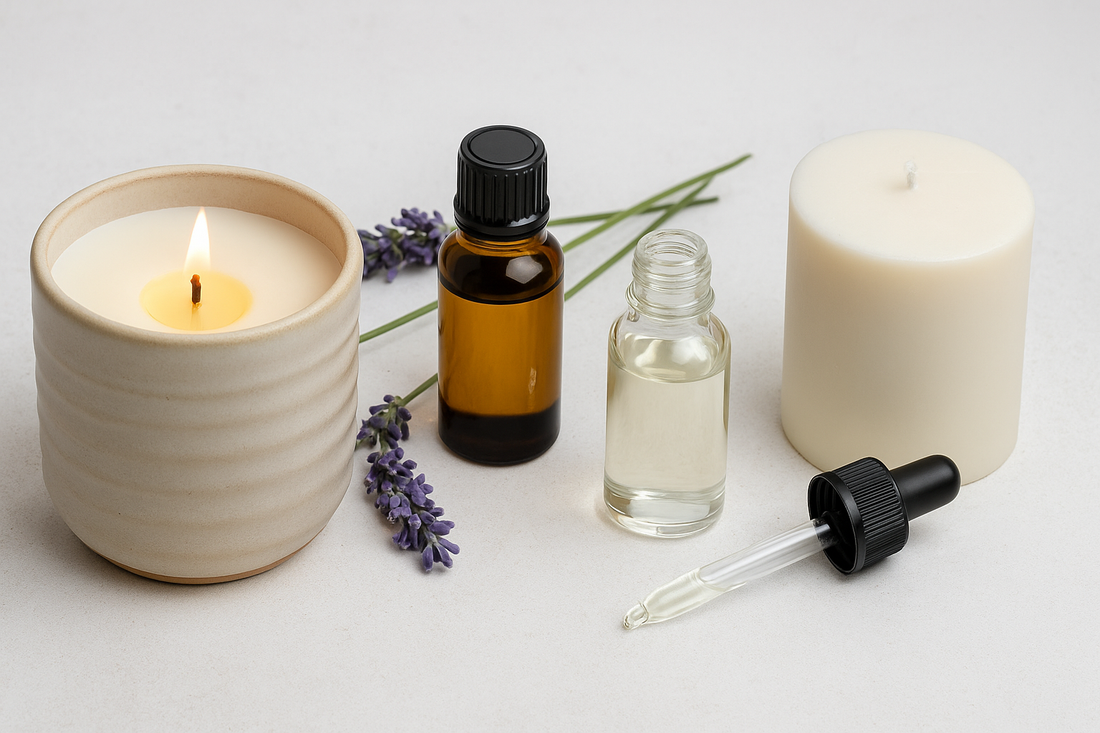What’s the real difference between essential oils and fragrance oils in candles—and why does it matter?
If you’ve ever scanned a candle label or browsed ingredient lists wondering which is “better,” you’re not alone. At ReCandle Co., we’re big believers in transparency and ingredient education, especially when it comes to what you’re burning and breathing in at home. Here’s what you need to know.
What Are Essential Oils?
Essential oils are aromatic compounds extracted directly from plants—think lavender, eucalyptus, or citrus peel. They’re known for being natural, and often linked with wellness benefits like relaxation or focus.
Because they’re derived straight from nature, essential oils can feel like the “cleanest” option when it comes to candle scenting. But in practice, they come with a few limitations—especially when heat is involved.
What Are Fragrance Oils?
Fragrance oils are either synthetic or blended scents designed specifically for use in products like candles, soaps, and perfumes. Some are made entirely from lab-created compounds; others are a mix of natural and synthetic ingredients.
The big difference? Fragrance oils are crafted to be more stable and consistent when burned—which is why many candles (including ours) rely on clean, high-quality fragrance oils to deliver a reliable and full-bodied scent experience.
Key Differences in Candles
Let’s break it down:
1. Scent Strength (Throw)
- Fragrance oils usually give a much stronger “throw”—they fill a room better and maintain their scent over time.
- Essential oils tend to be more subtle. You might catch a soft aroma when you lean in close, but they’re less likely to scent a whole space for long.
If you’re looking for a candle that makes your room smell amazing when you walk in, fragrance oils typically win here.
2. Heat Stability
- Many essential oils have low flash points, meaning they can evaporate or degrade quickly under candle heat.
- Fragrance oils are designed to withstand high temperatures, making them better suited to burning without breaking down or losing their scent.
That’s especially important in a refillable candle, where we want consistency across every burn and refill.
3. Scent Variety
Essential oils are limited to what plants naturally produce—lavender, peppermint, citrus, etc.
Fragrance oils? Sky’s the limit. You get complex blends like Amber Noir or Caribbean Teakwood that you just can’t pull from nature alone. That creative flexibility is what makes our lineup of candle refills feel so unique and modern.
4. Perception of “Natural”
- Essential oils are often seen as more natural or wellness-focused.
- Fragrance oils can raise questions—Are they safe? Are they synthetic?—but it depends entirely on the quality and sourcing.
We use fragrance oils that are clean, phthalate-free, and free from known toxins or irritants (more on that in a sec).
Why ReCandle Co. Chooses Clean Fragrance Oils
Our wax refills are made with 100% soy wax and premium fragrance oils—but not just any fragrance oils. We only use clean formulations that are:
- Free from phthalates, carcinogens, and anything on California’s Prop 65 list
- Safe for people, pets, and indoor air
- Designed for strong scent throw and consistent performance in our refillable candle system
These oils allow us to offer unique, elevated scents like Black Sea, White Eucalyptus, and Mediterranean Fig—without compromising on safety or sustainability.
And because we’re committed to zero waste design, it’s important that each soy wax refill burns beautifully, smells amazing, and pops in and out of your ceramic vessel with ease.
“Natural” Doesn’t Always Mean Better
It’s easy to assume that essential oils = good and fragrance oils = bad. But the truth is more nuanced.
Essential oils are natural, yes—but that doesn’t automatically make them safer or more effective in candles. In fact, some essential oils can cause issues when burned: fading scent, odd behavior in wax, or even potential safety concerns if used incorrectly.
We don’t think in absolutes—we look for ingredients that are non-toxic, high-performance, and aligned with our values. Clean fragrance oils give us that sweet spot: the sensory experience you want, the peace of mind you need.
Thinking About Making Your Own Candles?
If you’re dabbling in DIY, here’s how to choose between the two:
- Use essential oils if you love subtle, botanical scents and are okay with a gentler aroma.
- Use fragrance oils if you want bold, lasting scents and a more reliable burn.
- Always check the flash point, usage rate, and safety data for your oils—especially if you plan to gift or sell your candles.
And know that many small candle makers use a blend of both: essential oils for top notes, fragrance oils for structure and throw.
The Bottom Line
There’s no “one is better” answer—just different tools for different goals.
Essential oils are lovely for minimal, natural scents with aromatherapy appeal.
Fragrance oils offer strength, complexity, and consistency—especially when formulated to be clean and non-toxic.
At ReCandle Co., we choose clean fragrance oils because they give us everything we care about:
- A great-smelling home
- Safe ingredients
- A refillable, zero waste experience
- Beautiful, elevated scent stories you can’t find in essential oils alone
FAQ
Are essential oils healthier because they’re natural?
Not necessarily. Some essential oils don’t hold up to heat or can be irritating when burned. “Natural” doesn’t automatically mean safe—especially in candles.
Can you mix essential and fragrance oils?
Yes, and many makers do. Just make sure you’re using safe proportions and testing thoroughly.
Do essential oil candles have scent throw?
Very little. They may smell nice when unlit, but they often fade quickly once burning.
Which is better for refillable candles?
Fragrance oils tend to work better—they’re stable, consistent, and strong enough to fill a room without requiring heavy use.
